German pork knuckle (also called Schweinshaxe) is loved not only in Germany but also by food lovers around the world. But here’s the best part: You don’t have to travel to Munich or wait for Oktoberfest to enjoy it. With a few simple ingredients and the right technique, you can make authentic German pork knuckle at home, right in your kitchen. So grab your apron, preheat your oven, and get ready to master one of the most iconic dishes in European cooking.
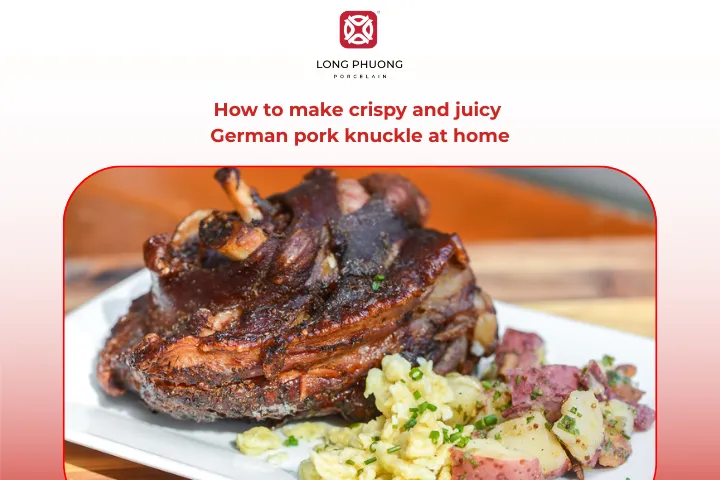
1. What is German pork knuckle (Schweinshaxe)?
Pork Knuckle, also known as pig knuckle, is unmistakably Bavarian. In Germany, it’s also called Schweinshaxe. These hefty roasted pork hocks are a fixture in pubs and beer halls in Munich, Germany, as well as in nearby Austria. Served swimming in rich, dark beer gravy, Pork Knuckle is cherished for its tender and flavorful meat, all encased in a crispy golden crust. One bite is enough to make you fall in love with this German classic. And once you do, nothing pairs better with a massive stein of cold beer.

2. Crispy German pork knuckle recipe you’ll fall in love with
2.1. Ingredients you’ll need for the German pork knuckle recipe
Pork knuckle
First, you need to get your hands on a pork knuckle. Don’t confuse it with pig’s feet—this is actually the meaty upper part of the pig’s leg. It’s also called pig knuckle, pork shank, pork hock, or ham hock (though ham hocks are usually smoked or cured). For authentic German pork knuckle, you want the rear leg hocks, because they’re bigger and meatier. Front leg hocks are smaller and often smoked for recipes like pea and ham soup.
Sometimes pork knuckles are sold as pickled knuckles, ham knuckles, or smoked knuckles. Lightly brined ones may work for this recipe for Schweinshaxe. But it is best to stick to raw, un-brined pork knuckles. One knuckle weighing around 1.2–1.3 kg (2.6–2.9 lb) is enough for two people. If it’s smaller, it might serve one very hungry person.
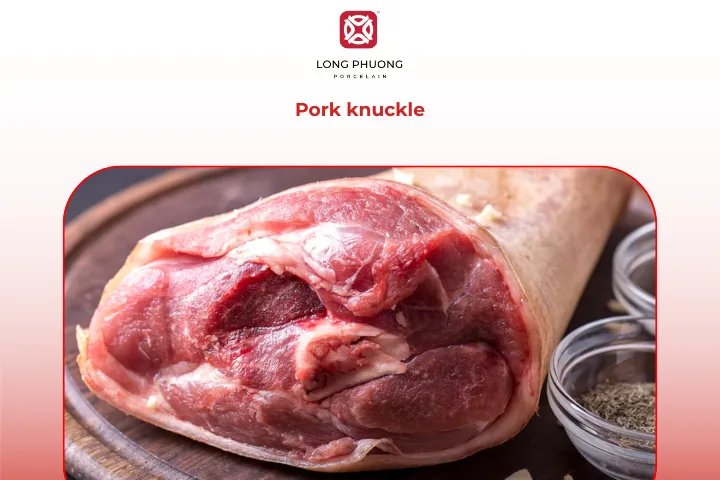
Seasoning rub
To prepare the pork knuckle for roasting, you’ll need a flavorful rub:
- Juniper berries, caraway seeds, and fennel: Traditional seasonings for German pork knuckle. Juniper berries might be harder to find in regular supermarkets, but you can get them from spice shops, delis, or fresh produce stores.
- Garlic: Slice into slivers and insert into small cuts in the pork for maximum flavor.
- Vinegar: Brushing vinegar onto the meat and skin helps reduce any strong pork smell. Don’t worry, it won’t make the pork taste sour.
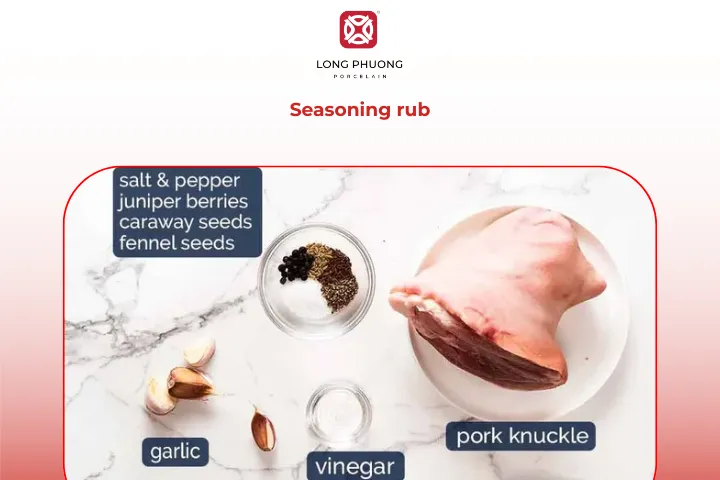
German beer gravy ingredients
The base comes from the pan juices left after roasting. Here’s what you’ll need:
- Dark German beer: This gives the gravy its deep color and signature flavor. If you can’t find German dark beer, any dark ale, porter, or stout will work. Just make sure it’s a proper dark beer; otherwise, the gravy will lack richness, sweetness, and color. Avoid overly bitter stouts, as they can overpower the gravy.
- Bay leaves, carrot, onion, and garlic: These are typical ingredients used for the flavor base.
- Chicken stock: Adds extra savory depth to the gravy. If you don’t have any, water can work in a pinch.
- Juniper berries: Echo the flavors in the pork rub.
- Salt and sugar: For seasoning.
- Cornstarch: Used to thicken the gravy. Because roasting the pork produces plenty of pan liquid, we need a thickener to stir straight into the stock to make the gravy. Cornstarch gives a clearer, smoother finish compared to flour.
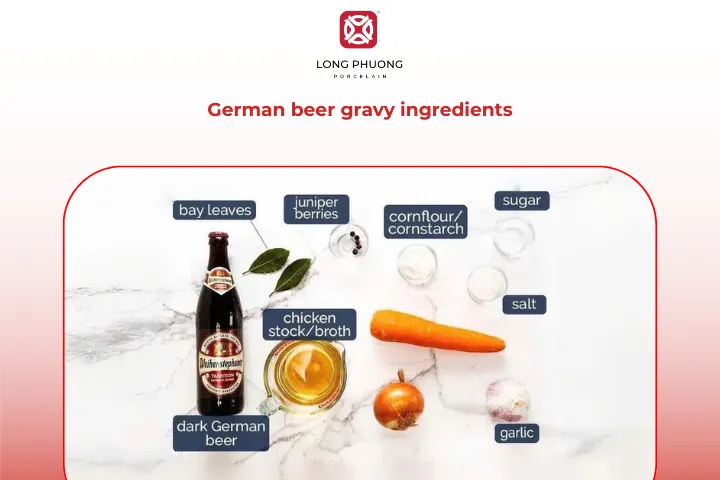
2.2. Step-by-step recipe for Schweinshaxe
Step 1: Preparation
1. Prick the skin
Use a small, sharp knife or even a clean sewing or safety pin to poke lots of tiny holes all over the skin. The more holes you make, the crispier the crackling will be. Skipping this step means the skin could turn out flat and hard. Be careful not to pierce through the fat under the skin and into the flesh. If you do, the juices will bubble up through the holes while roasting and make everything it comes into contact with not go crispy.
2. Brush the flesh with vinegar
Rub 1 tablespoon of the vinegar on the pork flesh, including inside any cracks or crevices, and under the skin where it meets the flesh (but don’t peel the skin back). The vinegar helps tone down any strong pork smell without changing the flavor. At this stage, only brush the flesh. You’ll brush the skin later during the final high-heat roasting step to make it extra crisp.
3. Stud with the garlic
Use a small knife to make shallow cuts in the exposed meat, then tuck thin slivers of garlic into each cut. This infuses the pork with deep, savory flavor as it roasts.
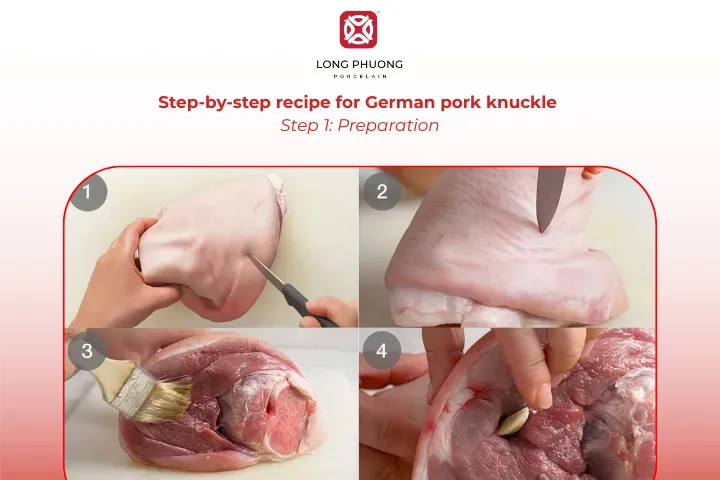
Step 2: Seasoning
1. Make the seasoning rub
Grind the spice mix using a mortar and pestle until you get a coarse powder. If you don’t have one, a spice grinder or a small blender.
2. Rub seasoning over pork
Rub the pork skin lightly with olive oil, then coat the entire pork knuckle, from skin, meat to all the crevices with your spice mix.
3. Skewer the skin
Pull the skin down so it’s stretched tight and smooth, then thread two metal skewers near the base of the knuckle in an “X” shape. Push them through one side, across the meat, and out through the other side about 2cm from the edge of the skin. This keeps the skin stretched during roasting for even, crispy crackling.
Tips:
- Try to pass the skewers as close to the bone as possible.
- Make sure you pierce the skin about ¾ inch (2 cm) from the edge—too close and it might tear while roasting.
- If you don’t have metal skewers, use soaked wooden or bamboo ones. Soak them in water for about an hour first to prevent burning, and trim off any excess ends.
4. Leave it overnight
Stand the pork upright on a plate and place it uncovered in the fridge overnight. This does two important things. First, it lets the seasoning soak into the meat for a deeper flavor. Second, it dries out the skin so it turns beautifully crispy when roasted.
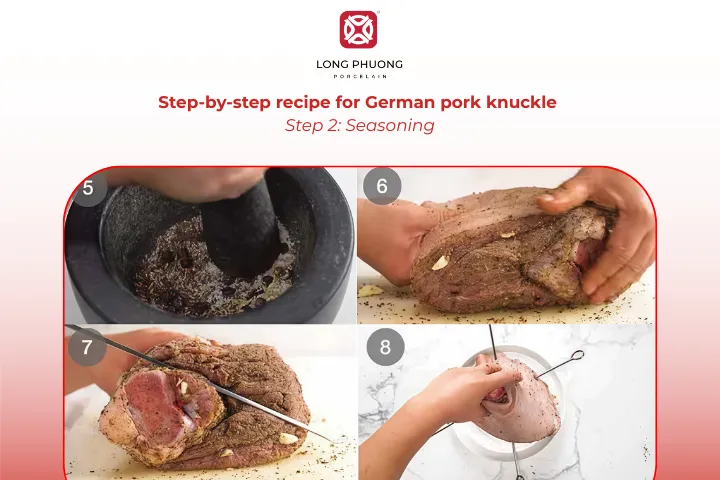
Step 3: Slow roasting
1. Prepare for roasting
Pour all the beer gravy ingredients into a roasting pan that’s deep enough to hold about 1.5 liters (around 3 quarts) of liquid. Place a rack over the pan, then set the pork knuckle on the rack with the cut side facing down. This setup helps the steam from the liquid keep the meat juicy and tender without softening the skin. Additionally, as the pork roasts, the flavorful drippings fall into the pan, creating a rich base for the beer gravy.
2. Slow-roast for 2 hours 10 minutes
Roast the pork at 350°F (180°C) or 320°F (160°C) if you’re using a fan oven, for about 2 hours and 10 minutes. Rotate the tray halfway, or until the internal temperature reaches 185°F (85°C) at the thickest part of the meat. Pork knuckle is not fatty or uniformly rich with connective tissue, so overcooking can dry out parts of the meat. It’s best to have a meat thermometer to achieve the ideal cook time for the flesh. Pork knuckle is still more forgiving than lean cuts, but precise cooking gives the best texture
3. After the slow roast
Once you pull the pork knuckle out of the oven, you will see that the skin looks dry and slightly rubbery. Don’t be alarmed! The skin needs to stay soft right now so it can puff up and form those irresistible, bubbly cracklings during the final high-heat roast. If it’s already crisp, the bubbles won’t form properly, and you’ll miss out on that perfect shatter.
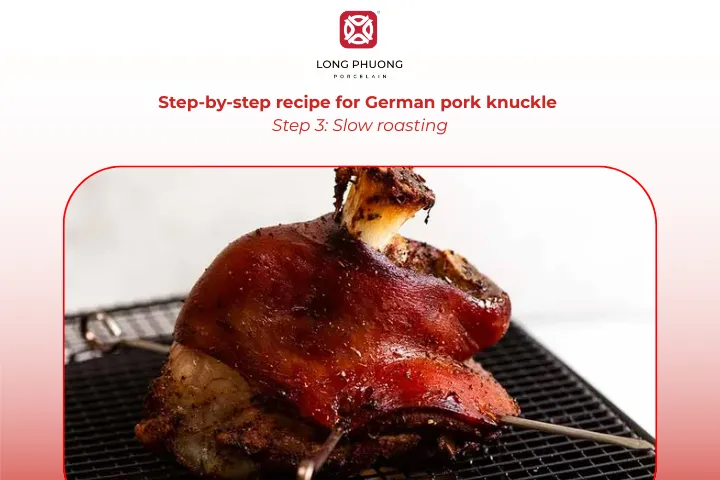
Step 4: Make that crispy pork knuckle crackling
1. Turn up the heat
Transfer the pork knuckle to a baking tray, then crank your oven up to 500°F (260°C) or 475°F (240°C) if it’s a fan oven. Crackling needs high heat to really pop. At this point, the liquid left in your roasting pan should be nicely reduced. That’s the flavorful base you’ll use to make your beer gravy later.
2. Brush with vinegar
Lightly brush the skin with half of the remaining tablespoon of vinegar. Don’t worry, it won’t affect the crispiness of the skin. The heat is so intense that the vinegar evaporates almost instantly. Its job is simply to help the skin puff up evenly.
3. Blast it
Roast the pork knuckle for about 30 minutes, rotating the tray halfway through. When you rotate it, brush the skin again with the remaining vinegar. Then, the skin should turn a rich golden color, blistered with tiny bubbles all over. It’ll be irresistibly crispy and audibly crackly when you tap it. Because of the knuckle’s round shape, you’ll never get quite the same even crackling as you would on a flat piece of pork belly, but this comes pretty close.
4. Let it rest
Once the skin is beautifully crisp, remove the pork from the oven and let it rest for 15 minutes. This short break allows the juices to settle back into the meat, keeping every bite juicy and flavorful. Skip this step, and the juices will just spill out the moment you cut into it.
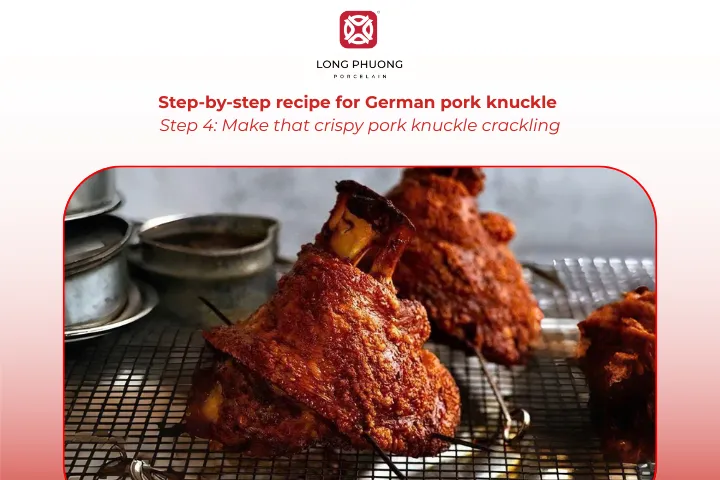
Step 5: German beer gravy
1. Strain the pan juices
Pour the juices from your roasting pan through a strainer into a saucepan. Don’t worry too much about the exact amount of liquid you end up with. It can vary depending on your oven, the size of your pan, or how much liquid evaporates during roasting. You’ll be able to adjust it easily later. If there’s too little liquid, just add a bit of water. If there’s too much, let it simmer a little longer to reduce and thicken. Aim for about 1½ to 2 cups of liquid, but the most important thing is to check the texture and taste. The right gravy should be smooth, rich, and full of flavor.
2. Thicken the gravy
Once you’ve got the right volume, bring the strained liquid to a gentle simmer. Mix cornstarch with a little cold water to create a slurry, then slowly pour it into the gravy while stirring. Let it simmer for about 2 minutes, until it thickens to a light syrup-like consistency.
3. Serve it up
Pour the finished gravy into a serving jug to serve alongside the pork knuckle, or go the classic Bavarian way: spoon a generous pool of gravy onto the plate first, then set the crispy pork knuckle right on top. Either way, once you pour that dark, malty beer gravy over the juicy meat and golden crackling, you’ll know why this dish is such a German favorite.

See more: How to make lemongrass chicken feet
3. Video tutorial on how to make German pork knuckle with beer gravy
4. Tips for making the perfect German pork knuckle
4.1. Choose the right cut
Pick a fresh pork knuckle (also called ham hock) with the skin on. The rear knuckle gives you more meat and deeper flavor, while the front is slightly smaller and easier to handle. Whichever you choose, the key is having that thick layer of skin for that irresistible crackling.
4.2. Dry the skin thoroughly
Pat the skin completely dry with paper towels. For the best results, leave it uncovered in the fridge overnight to air-dry. Moisture is the enemy of crispy crackling.
4.3. Score the skin properly
Use a very sharp knife to score the skin in a diamond or crisscross pattern, being careful not to cut deep into the flesh or fat. This helps the skin crisp up into bubbles and prevents the meat juices from seeping out and making the skin soggy.
4.4. Roast the pork knuckle properly
Roast the knuckle at 350°F (175°C) for about 60–90 minutes to render the fat and cook the meat evenly. Then crank the oven up to 450°F (230°C) for the last 15–20 minutes. This final blast turns that skin into a glorious golden crust that shatters with every bite.
4.5. Let it rest before serving
Patience is key. Let your pork knuckle rest for about 10–15 minutes after roasting. This helps the juices redistribute, keeping the meat succulent and tender when you cut into it.
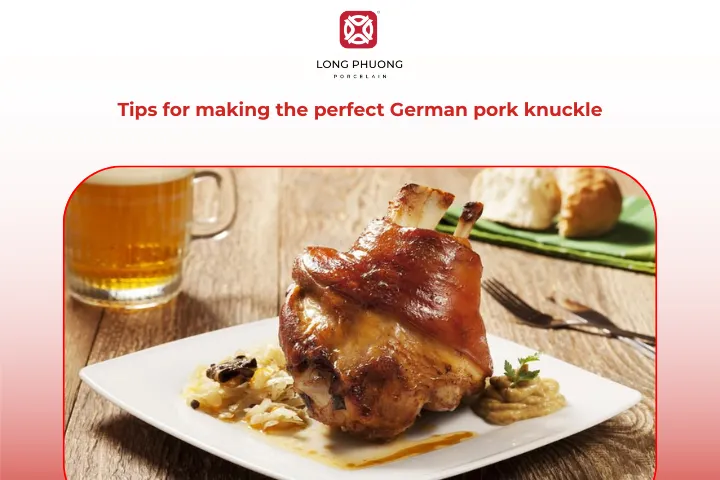
5. Side dishes to serve with German pork knuckle
5.1. Traditional sides pairing with German pork knuckle
- Sauerkraut: The tangy crunch of sauerkraut cuts through the pork’s fattiness and refreshes the palate. You can serve it warm with a little butter and onions or cold and crisp as a salad-style side.
- Potato dumplings: Soft potato dumplings soak up all that flavorful beer gravy perfectly. They’re a staple on Bavarian tables and a must-have for anyone recreating an Oktoberfest-style meal.
- Mashed or roasted potatoes: Creamy mashed potatoes absorb the gravy beautifully, while roasted potatoes offer a crispy contrast. Germans often drizzle them with melted butter or gravy for extra indulgence.
- Red cabbage: Red cabbage adds color and balance to the plate. Slowly simmered with apples, vinegar, and cloves, it provides a gentle sweetness that complements the savory pork.
- Pretzels or bread rolls: Freshly baked pretzels or crusty rolls are perfect for soaking up the dark beer gravy. They add a pleasant chewiness that rounds out the meal.
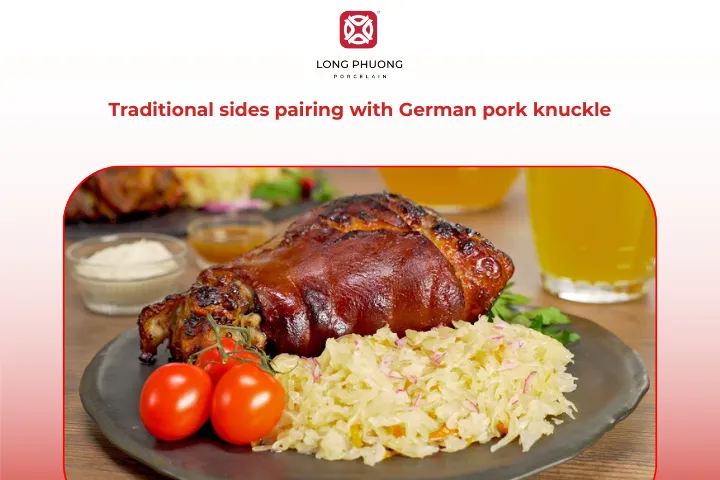
5.2. Modern sides pairing with German pork knuckle
- Roasted vegetables: For a lighter, colorful twist, pair your pork knuckle with roasted carrots, Brussels sprouts, or parsnips. Their flavor complements the pork’s richness.
- Creamy coleslaw: Swap out sauerkraut for a creamy, tangy coleslaw. It offers crunch and freshness, perfect for balancing the hearty texture of the meat.
- Garlic butter noodles: If you want something indulgent yet different, garlic butter noodles make an excellent side. The buttery sauce coats the pasta perfectly and pairs beautifully with the savory pork juices.
- Apple and fennel salad: A crisp apple-fennel salad brings sweetness and brightness to the table. It’s a refreshing way to contrast the deep, roasted flavor of the pork knuckle.
- Grilled corn or asparagus: For a summer-friendly twist, serve your pork knuckle with grilled corn on the cob or asparagus. The smoky, charred notes add depth and complement the roasted pork perfectly.

6. Best drinks to pair with German pork knuckle
6.1. Pairing beer with German pork knuckle
- Dark lager (Dunkel): A dark German lager, known as Dunkel, is the most traditional pairing for pork knuckle. With its malty sweetness, hints of caramel, and smooth finish, it goes perfectly with German pork knuckle and balances the saltiness of the dish beautifully.
- Märzen: Slightly toasty, rich, and medium-bodied, Märzen is the iconic beer of Oktoberfest. It enhances the pork’s deep, meaty flavor without overpowering it, making it a go-to choice for festive meals.
- Helles lager: If you prefer something lighter, Helles lager offers a crisp and refreshing contrast to the pork’s richness. Its subtle sweetness and mild bitterness make it ideal for daytime dining.
- Weissbier: For a softer and more aromatic experience, go for a Weissbier. Its fruity and spicy notes create an interesting contrast with the smoky, savory pork knuckle.
- Bock beer: If you want intensity, Bock beer is a strong, malty option with notes of toffee and roasted grain. It pairs especially well if your pork knuckle has a caramelized, crispy crust.
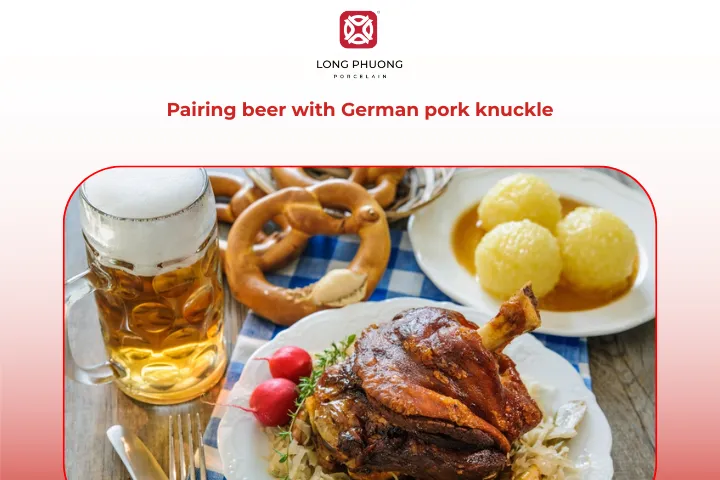
6.2. Pairing wine with German pork knuckle
- Riesling: A dry or off-dry Riesling is a perfect match. Its crisp acidity cuts through the fatty pork, while its fruity notes of green apple and peach complement the smoky flavors. It’s an elegant choice that brings harmony to every bite.
- Pinot Noir: For red wine fans, Pinot Noir is an excellent companion. Light-bodied with soft tannins and earthy undertones, it won’t overpower the pork but will enhance its roasted character.
- Grüner Veltliner: This Austrian white wine has zesty acidity and a subtle peppery note that pairs wonderfully with the richness of the German pork knuckle. It’s a refreshing alternative for those who enjoy white wine but want something less sweet than Riesling.
- Chardonnay: A lightly oaked Chardonnay brings buttery smoothness and depth that work well with the crispy, golden skin of the pork knuckle. Choose one with balanced acidity to avoid overwhelming the dish.
- Rosé wine: If you’re serving your pork knuckle outdoors or during warmer weather, a chilled Rosé makes a bright and refreshing companion. It bridges the gap between red and white, offering a fruity, crisp flavor that’s perfect for summer dining.
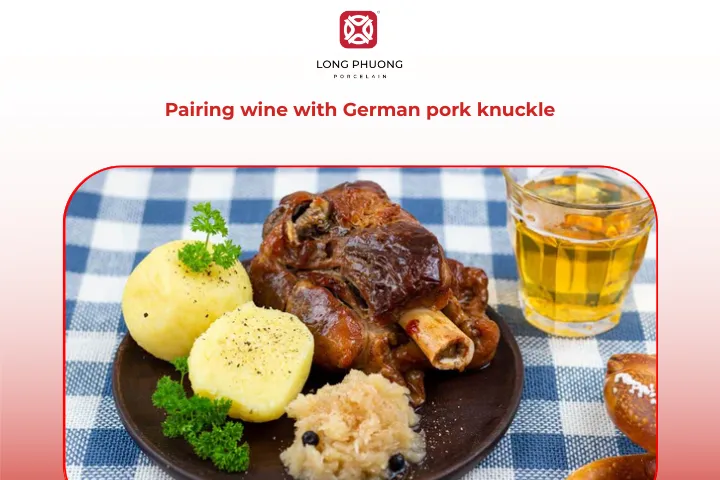
7. Common mistakes to avoid when cooking German pork knuckle
7.1. Skipping the drying step before roasting
Moisture is the enemy of crispiness. Many home cooks forget to pat the pork knuckle completely dry before roasting, which causes the skin to steam instead of crisp. For the best crackling, dry the skin thoroughly with paper towels and let it air-dry uncovered in the fridge for a few hours before cooking.
7.2. Using the wrong oven temperature
Cooking at a constant high temperature can make the skin burn while leaving the inside undercooked. The right approach is to roast low and slow first to tenderize the meat, then increase the heat at the end to achieve that perfect crispy crust.
7.3. Not scoring the skin
If the skin isn’t scored, the fat underneath cannot render out properly, leading to chewy skin instead of crisp crackling. Make shallow diagonal cuts on the surface before seasoning to allow the heat to reach the fat layer evenly.
7.4. Overseasoning or underseasoning
The pork knuckle itself has a rich, fatty flavor that needs balance. Overseasoning can make it overly salty, while underseasoning leaves it bland. Use a simple mix of salt, pepper, garlic, and herbs, and let the beer gravy add complexity.
7.5. Forgetting to rest the meat
Once out of the oven, the pork knuckle should rest for about 10 to 15 minutes before carving. This allows the juices to redistribute throughout the meat, keeping it moist and flavorful instead of drying out on the plate.

8. FAQs
8.1. Where to buy pig knuckles?
In Sydney, some butchers carry pig knuckles. However, you may need to ask because they’re often stored out of sight. Asian butchers are usually a good bet, and prices can be very reasonable. Just be sure to ask for rear leg knuckles and show them a picture if needed.
8.2. Are pig knuckles healthy to eat?
When eaten in moderation, pork knuckles can be part of a balanced diet. They are high in protein and collagen, which support joint and skin health. However, they’re also rich in fat, so it’s best enjoyed occasionally rather than as a daily meal. Pair it with plenty of vegetables to balance the nutrition.
8.3. Can I substitute any other meat?
Yes, you can substitute pork shoulder or pork belly if pork knuckle is unavailable. Both cuts have similar marbling and can deliver a tender, flavorful roast. However, the iconic crispy skin and gelatinous texture of the knuckle will be hard to replicate exactly.
8.4. What is a German pork knuckle called?
In German, the dish is called Schweinshaxe in Bavaria and Eisbein in northern Germany. While both use pork knuckles, Schweinshaxe is roasted until crispy, and Eisbein is typically boiled and served with sauerkraut.
8.5. How to eat German pork knuckle?
Traditionally, German pork knuckle is served whole with a knife and fork. The crispy skin is broken into bite-sized pieces, and the tender meat is enjoyed with sides like sauerkraut, mashed potatoes, or pretzels. It’s often paired with mustard or a dark beer gravy for extra flavor.
8.6. What is the perfectly cooked internal temperature for German pork knuckle?
The ideal internal temperature for a perfectly cooked pork knuckle is around 185°F (85°C). This ensures the meat is tender enough to pull apart easily while the skin turns golden and crispy. Always check the temperature using a meat thermometer for best results.
9. Elevate your German pork knuckle with Long Phuong Porcelain
A dish as impressive as German pork knuckle deserves to be served on an equally refined plate. That’s where Long Phuong Porcelain comes in. Long Phuong Porcelain is known for elevating dining experiences through craftsmanship, quality, and timeless beauty. Imagine your perfectly roasted pork knuckle, glistening under warm light, resting on a pristine porcelain platter. The golden crisp skin contrasts beautifully with the pure white surface, making every detail stand out.
Why choose Long Phuong Porcelain?
- Premium quality: Each piece is fired at temperatures up to 1380°C, ensuring superior strength, whiteness, and shine.
- Lead and cadmium-free: Safe for your family, safe for your food because true elegance never compromises health.
- Aesthetic design: Minimalist yet sophisticated, perfectly complementing traditional or modern dining styles alike.
- Versatile use: From casual dinners to festive feasts like this German pork knuckle, Long Phuong Porcelain brings elegance to every occasion.
Whether you’re hosting a dinner party or simply treating yourself to a comforting meal, presentation matters. With Long Phuong Porcelain, every dish becomes a celebration of taste and artistry. So next time you prepare your Schweinshaxe, place it on Long Phuong porcelain plates and watch your table transform into a masterpiece of culinary delight.
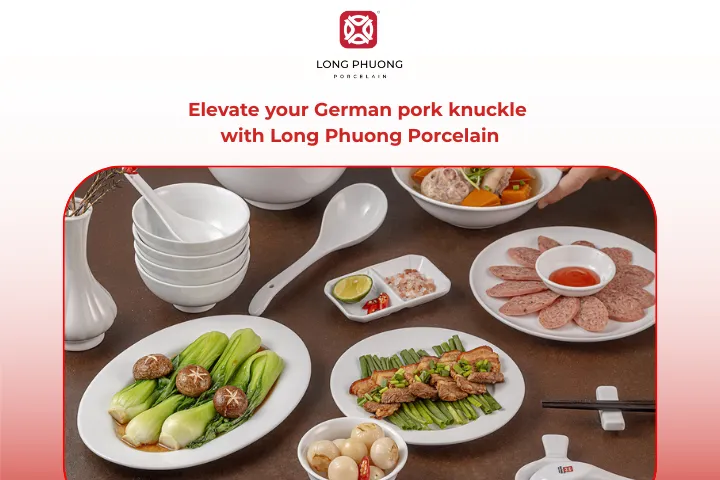
10. Conclusion
German pork knuckle is not only a delicious dish but also a symbol of European culinary tradition. With its meticulous preparation, perfect balance of spices, and use of fresh ingredients, this dish can impress any diner. To make it even more appealing, serving it on Long Phuong’s premium porcelain plates is the perfect choice. The combination of refined cuisine and beautiful presentation elevates the dish’s value and creates a truly memorable dining experience.
CEO of Long Phuong Group Joint Stock Company, with more than 20 years of exploration and research to obtain the best formulas and professional experience, Long Phuong Porcelain has produced more than 400 designs of all kinds of household porcelain, Significant contributions to Vietnam's ceramic industry.
 Vietnam
Vietnam
